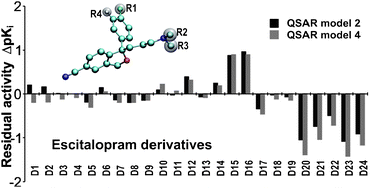3D-QSAR study indicates an enhancing effect of membrane ions on psychiatric drugs targeting serotonin receptor 5-HT1A
Abstract

* Corresponding authors
a University of Bucharest, Faculty of Biology, Dept. of Anatomy, Animal Physiology and Biophysics, 91–95th Spl. Independentei, Bucharest-076201, Romania
b
Institute of Biochemistry of the Romanian Academy, 296th Spl. Independentei, Bucharest-060031, Romania
E-mail:
amilac@biochim.ro

 Please wait while we load your content...
Something went wrong. Try again?
Please wait while we load your content...
Something went wrong. Try again?
S. Avram, A. Milac and D. Mihailescu, Mol. BioSyst., 2012, 8, 1418 DOI: 10.1039/C2MB00005A
To request permission to reproduce material from this article, please go to the Copyright Clearance Center request page.
If you are an author contributing to an RSC publication, you do not need to request permission provided correct acknowledgement is given.
If you are the author of this article, you do not need to request permission to reproduce figures and diagrams provided correct acknowledgement is given. If you want to reproduce the whole article in a third-party publication (excluding your thesis/dissertation for which permission is not required) please go to the Copyright Clearance Center request page.
Read more about how to correctly acknowledge RSC content.
 Fetching data from CrossRef.
Fetching data from CrossRef.
This may take some time to load.
Loading related content
